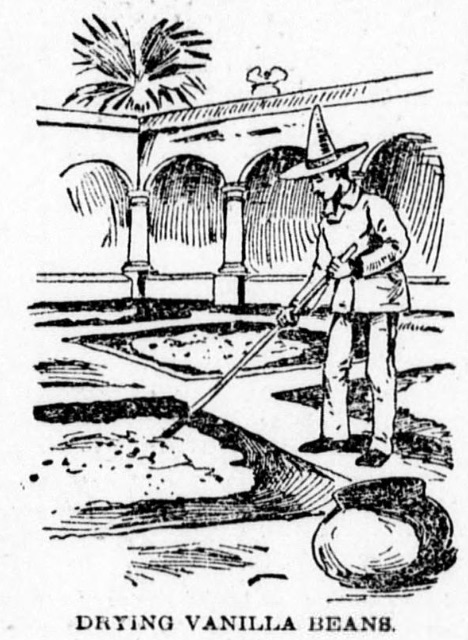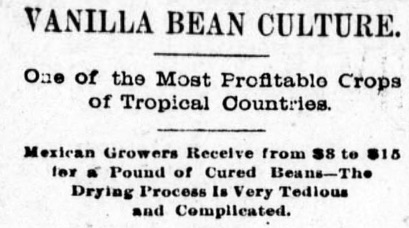
The article below describes how vanilla beans were grown and the process for curing them back in 1896.
Vanilla Bean Culture

Vanilla as a flavoring for ice creams and other delicacies, from once being considered a luxury, has now come to be so generally used that it is considered a necessity, and it would be very hard to find a substitute for it. Commercial extract of vanilla is obtained from the vanilla bean, which is a native of Mexico, and is probably the most valuable fruit grown, the best quality of Mexican beans often being worth nearly their weight in silver. While the vanilla is a native of Mexico, of recent years it has been transplanted to a number of different countries, and will grow in any locality where the temperature does not fall below 65 degrees F. The best beans, however, still come from Mexico.
The vanilla plant is a climbing vine with a stem about as thick as an ordinary lead pencil, covered with dark green spear shaped leaves.
The vines blossom profusely during March and April. The flower is yellow and has a very agreeable sweet smell. By far the greater number of blossoms wither and fall off, and the ones producing beans are a very small percentage of the total number. The beans grow very rapidly for the first two months, and by the 1st of July have attained their full size, and from that time on grow but little, if any. The beans, or pods, are from six to twelve inches long, and about half an inch in diameter, and when ripe are about the color of a banana, and have very much the same appearance, except that they are a little less in diameter and somewhat longer. Each vine yields about 100 beans, and some vines have a single branch that bear 12 or 15 pods.
From the 1st of July, when the bean is a dark green color, it grows but little in size, turning gradually a yellow color, until the last of December or 1st of January, when it is fully ripe and ready for gathering. The pods are filled with minute black seeds and a small quantity of pulp, and when prepared for market become reduced to about one-fourth their original thickness, are black in color, and emit a very sweet, agreeable perfume.

The curing of the beans is a slow, tedious process, and one requiring a great amount of care and attention. For the most part the growers do not cure their own beans, but sell them in miscellaneous lots to curers, who employ experts for that purpose. The total time consumed by the curing process is about five months. The beans as soon as gathered are spread out in the sun on black blankets, and allowed to remain until they are quite hot to the touch. They are then gathered up and placed in a sweating box, which is simply a wooden box large enough to hold all the beans. This box is well warmed in the sun, and its whole interior is then lined with blankets that have been out in the sun.
After the beans are in the box the ends of the blankets are folded over them and other warmed blankets are placed over and around the box. The whole is then allowed to remain for 36 hours by which time the ripest of the vanilla will begin to turn black, and the box will have lost most of its heat. The beans now have to be spread out in the sun again, and this process continued four or five times, until the beans are the proper color.
As the ripe beans turn black the quickest, after each sweating the whole lot has to be gone over, and the ones which are black enough picked out and placed by themselves. Great care must be exercised in this process, as, if they are very little over-sweated, it is sufficient to reduce the weight about one pound per 1,000 beans, which would be a great loss, and, as the bean loses part of its color when overtired, there is a further loss of about one dollar per pound on account of poor color.
As soon as the beans have been sufficiently sweated and are of the proper color they are spread out on drying racks, being carefully gone over from day to day, and any that show signs of moisture or mold are taken out and put in the sun until the mold disappears, when they are again placed on the racks. When of the proper dryness, which the operator from experience can judge very accurately by the feeling of the bean, they are taken from the racks and carefully assorted into bunches of 50, all the beans in one bunch being of the same length.
The price the beans bring depends entirely on their length and color, says the Chicago Record, and varies from eight dollars to fifteen dollars per pound. Each bunch of 50 beans weighs from a pound to a pound and a half, and a tin containing 40 bunches is worth therefore in the neighborhood of $500.
Source: Freeland tribune. (Freeland, Pa.), 28 Dec. 1896.

